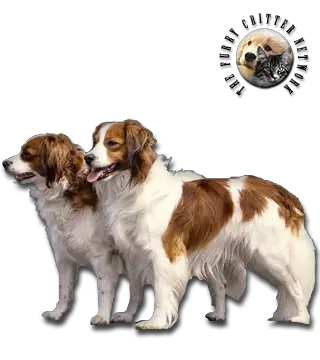Breed Standard
Head: Carried high. Fairly broad, moderately domed skull. Stop not very pronounced. Muzzle the same length as the skull. Lips not pendulous.
Ears: Medium-sized, hanging flat against the cheeks, covered with long hair.
Eyes: Almond-shaped, dark brown.
Body: Square build. Straight, well-muscled neck. Chest well let-down with moderately well-sprung ribs. Solid back.
Tail: Carried level to the ground or somewhat merrily, never curled. Well-feathered.
Hair: Medium in length, smooth, slightly wavy, not curly or too fine. Thick undercoat.
Coat: Patches ranging from orange to red distributed over a white background such that the color is dominant. Black with white patches and tricolor patterns are not allowed.
Size: 35 to 40 cm (14-16 in).
Weight: 10 to 15 kg (22-33 lb).
History
The Kooikerhondje was developed in the Netherlands sometime prior to the 16th century to be a breed to lure ducks into traps, a technique also called tolling. They were used to lure 'kooien' (cages in the form of canals with traps at the ends), where the hunter could easily catch the fowl. The dogs that were used by the Kooiker for this kind of hunting technique, were referred to as the 'Kooiker's hondjes'. Eventually this led to this dog being called Kooikerhondje.
The breed almost became extinct during World War II until Baroness van Hardenbroek van Ammerstol rescued it. The breed was only officially recognized by the Raad van Beheer, the Dutch Kennel Club, in 1971 and has since been imported into other countries and recognised officially. The breed is still relatively unknown in North America and not yet recognized as a breed in Canada, although it was accepted into the AKC's Foundation Stock Service Program, in 2004. The breed was moved to the AKC Miscellaneous Class on July 1, 2015 in preparation to moving to the Sporting Group upon full recognition. As of Jan 1, 2018, the Nederlandse Kooikerhondje has been fully recognized by the American Kennel Club and is now competing in the Sporting Group. In the United States, both the UKC and ARBA recognize the breed.
In the U.K., the breed has been removed from the import list and is now eligible to enter Crufts for the Best in Show award, despite there being only 76 of the breed in the U.K.
Some historians believe the Kooikerhondje may have possibly played a part in the development of the Nova Scotia Duck Tolling Retriever.
Behavior
Kooikerhondjes are cheerful, good natured, friendly, quiet, well-behaved, and alert. Depending on its domestic environment, it is kind, happy and lively. They are also intelligent, attentive and more than willing to please their owner. The Kooikerhondje adapts to situations rather quickly, changing his behavior from quiet to lively when the situation allows them to be. They will not always immediately like strangers, instead choosing to retreat. But once they warm up to someone, the trust will be there for the rest of their life. The Kooikerhondje can make a fine apartment dog if exercised regularly, but a fenced yard will be more ideal. They have a medium energy level, yet are usually quiet when indoors. Kooikerhondje can be reactive with strange dogs and are wary of boisterous children, in general. Overall, Kooikerhondjes are great companions.
Function
Hunting Dog, Pet.
Health
Kooikers have good appetites and a tendency to put on weight easily. As Kooikerhondjes have a small genetic base, hereditary diseases are somewhat prevalent. These include:
von Willebrand's disease, a blood clotting disorder preventable through DNA testing. Today most Kooikers used for breeding are free from von Willebrands disease (most national clubs require both male and female dogs to be free from this disease to be allowed to breed).
Cataract and other eye diseases
Patellar luxation, is not a major problem in most countries at the moment, but is kept under a close watch to prevent it from becoming a problem again. In the Netherlands, eye tests are available and all breeders breeding according to the breed club's rules have to test their dogs. Only dogs that are free of eye diseases are allowed to be used for breeding.
Hereditary Necrotising Myelopathy (ENM), a fatal neurologic disease also preventable through DNA testing. Testing for ENM became available in 2012. In the Netherlands, only dogs who are tested may be used for breeding. Only allowed breedings are Free x Free or Free X Carrier. Carrier to Carrier should never be done as the risk of this fatal disease is high. Puppy purchasers should inquire about the ENM status of the parents.
Polymyositis
Epilepsy, a central nervous system disorder that causes dogs to have recurring seizures
Kidney disorders






